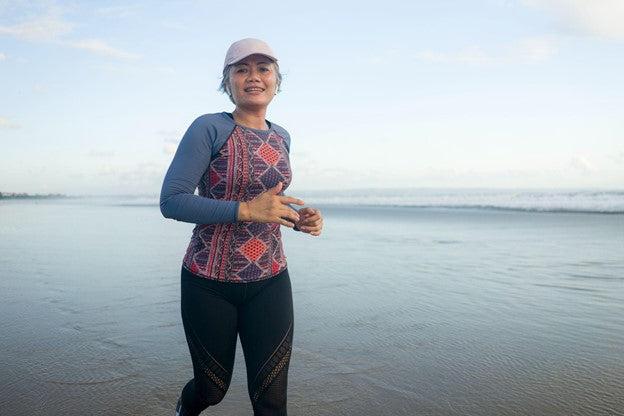
How Womens Fitness Can Reduce Menopause Symptoms
Share
Exercise is beneficial. There's no argument about that point. But it is extremely advantageous for a woman during menopause. Physical and emotional symptoms interrupt daily routines and sleep habits. Exercise plays a huge role in easing symptoms and restoring a semblance of balance to a woman's changing body. Several workouts are easy to incorporate into your daily routine. Most require minimal equipment and can be performed at home. Give your body the tools it needs for a smoother transition into a new phase of your life.
What Is Perimenopause
Perimenopause is the period before menopause. It is also the phase when most women experience symptoms of transitioning to menopause. Women typically experience perimenopause between 45 and 60 years of age. This stage can last anywhere from a couple of months to ten years or longer. There is no set start date nor a timeframe for the duration. Each experience is unique.
Perimenopause is the body's way of letting us know changes are coming. During this time hormone levels decrease causing egg production to slow down. A woman usually encounters irregular or heavier periods. This is when most, but not all, women feel the widest range of symptoms. These lingering side effects can occur throughout perimenopause and menopause.
A perimenopause diagnosis is made based on presenting symptoms. A blood test is available but is not always accurate. That is because a woman's fluctuating hormones are all over the map. They may be normal one hour and off the charts the next. Even with the blood test relying on two separate draws, six weeks apart, it may still produce inaccurate results. Many practitioners encourage their patients to keep a symptom diary. Journaling will show a pattern of symptoms that reveal over time.
Menopause happens once a woman has not experienced a period for twelve months or more.
Perimenopause Symptoms
As previously mentioned, this journey is unique to each woman. Women experience both physical and mental side effects from perimenopause. The following are the most common symptoms that will differ in length and intensity.
Physical Symptoms
- Hot flashes accompanied by night sweats
- Menstrual cycle changes. These changes may include irregularity and/or heavier flow
- Dizziness
- Headaches
- Vaginal dryness
- Weight gain
- Muscle and joint pain
- Incontinence and other bladder issues
- Trouble sleeping
- Decreased sex drive
Mental Wellness Symptoms
- Anxiety
- Brain fog - trouble concentrating and remembering
- Depression
- Mood swings
How Womens Weightlifting Helps With Menopause Symptoms
Perimenopause is a Herculean act performed by a woman's body. The consequences affect her body in a myriad of ways. For one, oestrogen levels decline. Declines in hormones can lead to reduced muscle mass, muscle strength, and bone density. Other impacts present in cardiovascular and mental health. Although HRT (Hormone Replacement Therapy) is the main method of alleviating these symptons, exercise is another way to reduce symptoms and increase our coping mechanisms.
Protects Bones
Osteoporosis is a condition that menopausal women are prone to develop. Less oestrogen in the body affects bone health directly. The results show up in brittle and weak bones. Increased exercise strengthens bones and the supporting muscles. Perimenopause is the time when most women will undergo a bone density test. Muscle-strengthening and woman weightlifting exercises help a woman's bones build and maintain density.
Improves Cardio Health
Oestrogen levels decline with menopause. This decline can raise bad cholesterol. It is also responsible for decreasing good cholesterol. Cardio exercise elevates your heart rate while engaging large muscle groups. Quicker breathing pumps blood flow to organs and strengthens the heart.
Regulates Sugar Levels
Oestrogen also keeps insulin levels regulated. Once oestrogen levels drop, the body produces too much insulin. Too much insulin in the body leads to hot flashes, weight gain, fatigue, and insulin insensitivity.
Keeps a Body Flexible & Balanced
Regular stretching and resistance workouts keep joints supported and flexible. Good flexibility is a necessity as we age to prevent falls and injury.
Improves Pelvic Floor Support
The muscle group covering the floor of your pelvis weakens during menopause. These muscles hold up your uterus, bladder, and bowel. Exercise helps you to maintain bladder control when you sneeze, laugh, or cough. A strong pelvic floor also helps with pleasurable sex.
Keeps a Handle on Weight Gain
Changes in hormones during menopause can equal extra pounds on the scale. A slower metabolism can get a kick-start with regular exercise.
Lessens the Severity of Symptoms
While nothing will remove menopause symptoms altogether, regular exercise can reduce the severity. Hot flashes reduce with physical activity. Women who lead sedentary lives experience much more intense symptoms than women who exercise.
What Types of Workouts Reduce Menopause Symptoms?
The average UK woman reaches menopause at around 51 years. By this age, bone density and muscle mass have experienced declines for close to twenty years. A woman's metabolism has also slowed down. Regular physical activity can provide benefits that last well past menopause. Don't think of exercise as needing to spend hours spent in the gym or miles pounding the pavement. Instead of a taxing session lasting twenty minutes, space out four sessions lasting 5 minutes. A woman in good health can recognize benefits from 2.5 hours per week of moderate aerobic exercise or 1.25 hours of heavier aerobic exercise.

Walking or Hiking for Cardio
Now, this is something we can all fit into our day. Walking delivers two benefits to a woman progressing towards menopause. First, walking raises cardio activity without flooding the body with stress. Your metabolism elevates with minimal effort. A raised metabolism helps to burn off extra calories and stored fat. Second, walking has beautiful mental health advantages. Walking in nature can clear your mind as well as lift your emotions.
Suggested Workout
Start with 10 minutes of light activity. The cardio activity could include walking, hiking, swimming, or jogging. Once this level feels comfortable, slowly increase the duration. You can also break up your sessions into several short periods to see the same benefits.
Yoga
Yoga and meditation relieve stress. They also increase flexibility and balance. Yoga can start at any age. Beginners can see benefits almost immediately. Meditation while practising yoga can also be a great pain reliever. Since a woman's body decreases hormone production, symptoms can overrun a feeling of health. Less intense workouts, such as yoga, prevent symptoms from increasing in severity. Reduction in symptom severity happens because the stress hormone, cortisol, does not increase during a low-intensity workout. Yoga can even stimulate glands that regulate hormones.

Suggested Workout
Start with a few poses per day. Or spread them out throughout your week. Begin with
- Head-to-knee pose
- Reclining hero pose
- Reclining bound angle pose
- Child's pose
Strength Training and Womens Weight Lifting
Never picked up a dumbbell or weights in your life? That's perfectly fine. It is never too late to start gaining the benefits from strength training. Your bones will thank you for it as you progress through the menopause cycle. Choose dumbbells or resistance bands if you opt to work out at home as they are versatile and effective. While at the gym, use a selection of free weights such as kettlebells, dumbbells and medicine balls to keep your routine varied. Barbell training is popular in class activities such as Body Pump and you can alternate weights to suit your level. Only enough weight is needed to feel your muscles working. Similarly, trying out group classes that feature a mix of cardio and strength training is a great way of increasing confidence and building lean muscle.
Suggested Workout
Always start by warming up your muscles and cardio. A warm-up should be 10-15 minutes. You can ride a stationary bike, walk on a treadmill, or use an elliptical. Two to three times a week is needed to keep bone density levels. Your workout can be one thirty-minute session. Or you can spread out the thirty minutes across your week. Start with twelve repetitions using weights that challenge but don’t overload your muscles.
Dancing
Who said that exercise had to be boring? Dancing is a cardio activity that gets your lungs expanding and burns calories. Dancing is an excellent alternative to a mind-numbing treadmill if that's not your thing. You'll build muscle and flexibility while you turn, dip, and spin your way to a healthier you.
Suggested Workout
Aim for 75-150 minutes per week. Break it up into manageable chunks of time. The important thing is to elevate your heart rate and control your breathing. If you can't talk whilst dancing, it's time to rest.
Stairmaster or Elliptical Trainer
Both of these machines are available in most gyms. They provide a great cardio experience with little to no stress impact on joints. Either is a great alternative
to running.
Suggested Workout
A Stairmaster or elliptical trainer is a way to get in interval training that will aid the cardio system and build muscles. Start your intervals after a 10-minute warm-up. Begin full-bore for 20-30 seconds. Then slow down the pace for 30-120 seconds. Repeat this 5-10 times. Gradually work up to a 25-minute session.
Protect Your Body With Exercise
By now, you realize the importance of exercising during menopause. Not everyone will want to do every exercise, and that's okay. Try everything until you find a method that works for you. Be realistic with fitting fitness into your daily routines. Pay special attention to the messages your body sends you. Activities that were effortless in your youth may require more frequent breaks and shorter durations. Your body will thank you.
You may also be interested in:
Echelon Connect Bike: A Cycling Experience like no other
